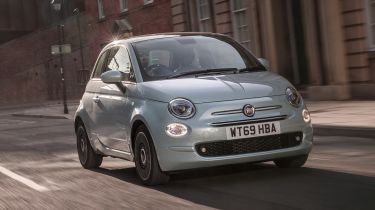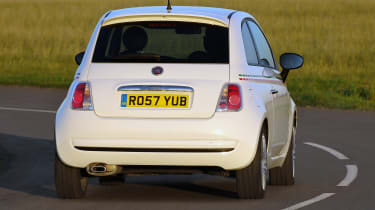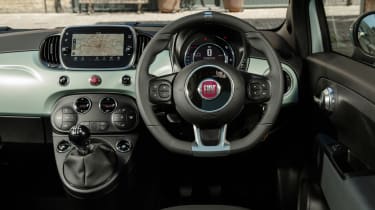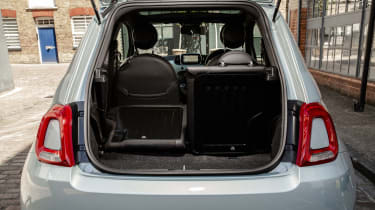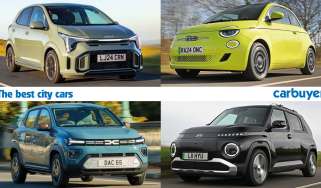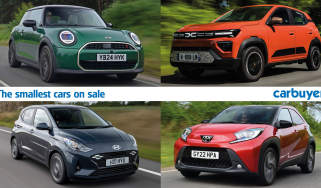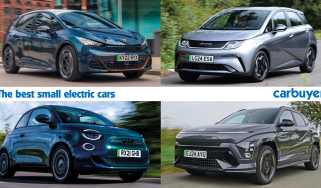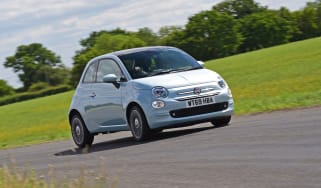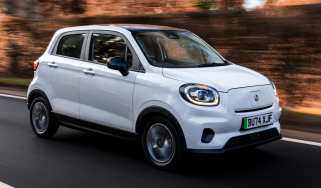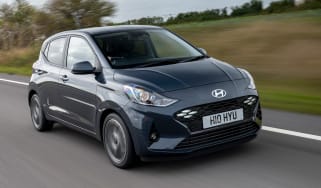Used Fiat 500 review: 2008 to present (Mk1)
"The Fiat 500 is one of the most fashionable cars on the road, yet it’s also one of the most affordable as a used buy"
Pros
- Attractive styling
- Cheap to buy and run
- Easy to drive
Cons
- Not much space inside
- Many examples have not been well looked-after
- Not suitable for tall drivers
The Fiat 500 is one of the most popular city cars around thanks mainly to its trendy looks, but there are plenty of other reasons to consider one as a used car. Since it was a big seller, there are plenty of used examples to choose from and the earlier models can be bought for very little money.
It's also cheap to run and easy to drive, so it’s a good first car for young drivers as well as being appropriate for those in the city who need a small car that’s easy to park. It’s not very practical and you need to take care when buying to avoid models that have not been looked after, but the 500 is well worth considering if you’re after a great value used city car with a dash of style.
The Fiat 500 is one of the most popular, trendy and recognisable city cars ever made. The model, which was first launched in 2008 and, inspired by the success of the reborn MINI, used retro styling based on the classic Fifties original model to great effect.
Fiat's 500 is closely related to the second generation Ford Ka, with which it shares many parts and was built in the same factory. The Fiat was far more successful than the more conventional looking Ford, making it clear that its styling was a big factor in the 500’s popularity. The 500 also pulled off the trick of appealing to a wide audience, being more affordable than other retro models like the Volkswagen Beetle and MINI, but with more character than cheaper city cars such as the Citroen C1, Renault Twingo and Toyota Aygo.
More reviews
Fiat also gave 500 owners a huge amount of choice to personalise their new car with bright paint colours, alloy wheels and trim highlights. If this wasn’t enough, the addition of decals and accessories could make the 500 stand out even more, so it’s important to know what’s fitted to the Fiat 500 you’re interested in buying. You might also want to seek out the Fiat 500C, which features a full-length canvas panoramic sunroof that opens down to the bootlid, rather like the one on the DS 3 Cabrio.
What’s the history of the Fiat 500?
When the Fiat 500 first launched in 2008, there were 1.2 and 1.4-litre petrol engines to choose from, as well as a 1.3-litre diesel. During 2009, Fiat added a 1.2-litre fitted with a fuel-saving stop-start system, while an Abarth-badged hot hatchback arrived with a 1.4-litre turbocharged petrol with 135bhp.
In 2010 a 0.9-litre TwinAir engine arrived, getting its name from its two-cylinder layout. Despite its small size, power was an impressive 85bhp, while an even more powerful version arrived in 2014. Also in 2010 the 1.3-litre Multijet diesel was given a power boost to 95bhp.
In 2016, the Fiat 500 received a mid-life facelift, with trim updates and new exterior styling, including redesigned headlights and bumpers, but it still looks similar - Fiat didn’t fix what wasn’t broken with the looks. In 2020 a mild-hybrid model was added to the range with a three-cylinder petrol engine and a tiny electric motor to boost efficiency.
The third generation Fiat 500 launched in 2021 still looks really similar, but all versions are electric. It only half-replaced the petrol 500 as both are on sale from Fiat at the same time.
Which is the best Fiat 500 to choose?
Special-edition and high-spec Fiat 500 models are sure to be desirable for many buyers, but they can cost a lot more than regular cars. Even the entry-level 500 Pop has electric windows and key fob remote central locking, while air-conditioning, Bluetooth and alloy wheels are available with the Sport and Lounge.
Used buyers can get a lot of 500 for their money, so we’d recommend avoiding the Pop and going for a Lounge or Sport model, which may be fitted with a sunroof and tinted rear windows, along with any options chosen by the first owner. As long as they fit your personal taste, then you’ll have no trouble finding examples with extra decals, bright colours and upgraded wheels.
The 1.4-litre petrol is the best engine to go for if you’re looking at early 500s, being much livelier than the 1.2-litre, which quickly feels out of its depth if you leave the city streets and head out on the open road. The TwinAir engines make a raspy noise, which suits the character of the car, but they also thrive on revs, so it’s difficult to get anywhere close to the claimed fuel-economy figures.
The TwinAir does offer sprightly performance, but if you’re after a long-distance car or plan on driving lots of miles each year, the diesel is the best option. It’s not as much fun as the petrols, put it’s a surprisingly muscular performer and delivers excellent fuel economy.
What are the alternatives?
The Fiat 500 is a stylish small car, so the MINI hatchback is an obvious competitor - after all, both these models are designed to remind us of their tiny 1950s and 1960s ancestors. The MINI is a better car overall than the 500, as it’s better to drive and feels more upmarket, but that’s reflected in the price and it costs a bit more to run as well.
Other rivals for the Fiat 500 include the Volkswagen Up!, SEAT Mii and Skoda Citigo, as while these small city cars aren’t as stylish as the Fiat, they are just as cheap to run yet more practical and even better to drive. The Hyundai i10 and Kia Picanto are other options, offering impressive value for money, greater space and a more grown-up driving experience.
Running costs, MPG, CO2 emissions and insurance
The Fiat 500 is a small car with smaller engines, so it should be really cheap to run
The Fiat 500 has been on sale since 2008 and that means the earliest examples are now quite elderly in used car terms. These versions can be bought at extremely low prices, yet they still look just as stylish as the most modern examples, so they can be a bit of a bargain - as long as they’ve been looked after.
With this in mind, it’s important to make sure any car you’re looking at has been serviced according to the recommendations made by Fiat. There are so many available on the market that you can always walk away and find another one that’s right for you.
Since the 500 is a small, light car and parts are readily available, it should be really cheap to run. Not only are the engines economical, things like brakes and tyres will last longer than on a larger, heavier family car, plus they’ll cost less to replace when they do wear out.
How much does a used Fiat 500 cost?
There’s a huge amount of variation in the cost of a used Fiat 500. You can check our sister site Buyacar for the latest prices, but in general 2008 models cost only a few thousand pounds (depending on condition) and you’ll pay up to about £18,000 for a top-of-the-range nearly-new model. This is roughly in line with other city cars, such as the Volkswagen Up!.
That’s not including the more expensive all-electric Fiat 500 that arrived in 2021 and uses the same name as the internal combustion engined car but is all-new from the ground-up. That car is still quite pricey, although it’s an excellent product and well worth a look if you can afford it.
What’s it like for fuel economy, emissions and tax?
The method of measuring fuel economy for official figures changed over the years that the Fiat 500 has been on sale, which means the more modern models look less economical on paper - but in reality, all Fiat 500 models will be cheap to run and versions with the same engine will offer similar MPG returns in real-world use.
The petrol models are the most popular and they are the best fit for a city car. The 0.9-litre TwinAir petrol is a tiny two-cylinder motor and is claimed to return around 70mpg, but it’s unlikely you’ll achieve it in reality, because the engine needs to be revved harder to get up to speed.
The earlier 1.2-litre petrol will return around 55mpg according to the paper figures, and the larger 1.4-litre motor manages a reasonable 50mpg. We would expect 35-45mpg from all of these petrol engines in the real world.
Adding an auto gearbox will reduce efficiency next to a manual model - the 1.2-litre engine managed only 46.3mpg and CO2 emissions of 138g/km in auto form, for example.
Later on, a 1.0-litre mild-hybrid motor was added to the range. It uses a tiny electric motor to help improve efficiency and returns 53.3-56.5mpg, with CO2 emissions of 105g/km.
With emissions of less than 100g/km of CO2, TwinAir models registered before April 2017 are tax-exempt, while the 1.2-litre costs £30 a year and the 1.4-litre petrol £135 a year. At opposite extremes, the 1.3-litre diesel has the best fuel economy in the range (around 70mpg) and costs £20 to tax annually. All models registered after April 2017 cost £155 a year to tax.
How much will it cost to insure?
Low insurance costs mean the Fiat 500 is great for young drivers. It’s not quite as cheap to cover as a Skoda Citigo, but you can get 500 models as low as group 3 (the 1.0-litre mild hybrid in “Hey Google” special edition trim), which is impressive. The other trim levels with the 1.0-litre engine are a bit more expensive, being rated up to group 9.
The much more common 1.2-litre petrol sits around groups 5, 6 and 7 depending on trim. The 0.9-litre TwinAir costs a little more, being in groups 10 and 11 for the most part, and the 1.3-litre diesel models are generally in groups 13 and 14 along with the larger 1.4-litre petrol.
Reliability and common problems
The Fiat 500 is actually a pretty tough little car, but even so it’s best to make sure you buy one that’s been looked after well
There are loads of Fiat 500s for sale from as far back as 2008, so reliability is likely to be pretty mixed. We wouldn’t worry too much about buying one that’s only a couple of years old, but an early model could be nearly 15 years old by now and could be needing some mechanical attention. If you are looking for a cheaper Fiat 500 as a second-hand car then make sure you are going to buy one that has been looked after. That said, it’s a fairly robust and simple car that’ll withstand a fair amount of abuse, while any mechanical repairs should be straightforward.
Even so, evidence of service history, repairs and other maintenance is desirable. Don’t accept any excuses - if a car doesn’t have any service history, treat it as if it’s not been touched in years. In other words, walk away - there will always be another 500 just around the corner, simply because so many were sold.
How reliable is the Fiat 500?
The Fiat 500 requires fairly infrequent maintenance, with services every 18,000 miles or two years, or customers can choose an annual service for cars with an annual mileage of less than 9,000 miles. It’s important to check which service is due next, as prices vary and they can be costly.
The first and third services are cheapest, but still quite pricey for a city car, while the second is about twice as much and the fourth is most expensive, because with a new cambelt required, you’re looking at an eye-watering bill (that said, the 1.2-litre is known as a ‘non-interference engine’, so if the belt does snap it won’t require and expensive rebuild like others.
Other costs to consider include an air-conditioning refresh every three years and the brake fluid, which will need draining and topping up every couple of years.
Are there any common problems or things to look out for?
As most Fiat 500s spend their lives in town, inspect the wheels for signs of heavy kerbing, which could be a sign that the car’s tracking is off, leading to uneven tyre wear. Also, ensure the clutch and brakes operate as you’d expect, as a lot of Fiat 500s are used by driving schools and learner drivers. If the handling feels overly twitchy or the ride is poor, check the tyres aren’t over-inflated.
Other common issues include fragile interior trim that can snap off or crack and soft paint that is easily marked by bird mess or stone chips. You should also check that quality oil has been used for servicing if possible, as it can be a cause of trouble, especially for the diesel motors.
What about recalls?
Dating back to 2009, there were Fiat 500 recalls to rectify issues with the rear brakes and the next year there were recalls for the steering and airbags. The brakes were the subject of another recall in 2012, while the fuel system was a problem again in 2013.
In 2015 the 500 was recalled for potential seatbelt anchoring issues, then in 2016 there was a fix for reduced braking performance. The electric power steering was subject to a recall in 2017, then in 2019 a fix for a drive shaft was issued. Most recently in 2021 there were recalls for drive shafts again and the start-stop system.
It’s important to ensure all remedial work has been carried out when buying a used 500.
What do owners think?
The Fiat 500 has a somewhat turbulent record in our Driver Power surveys, finishing 87th out of 150 models in 2015, 142nd in 2013 and failing to make the top 150 in 2016. Luggage space, build quality and reliability were worries for owners.
Later, in the 2020 poll the Fiat 500 came in 45th place out of the top 75 cars and five per cent of owners reported having trouble with their car. In 2021 the car dropped to 67th place in the poll and Fiat finished poorly in the manufacturer section as well.
Engines, performance and drive
The Fiat 500 is fun to drive around town but some of its rivals are more comfortable
The Fiat 500 excels in town because its small size and good visibility mean it’s easy to drive and park. You can fit through gaps that others will have to wait around for, and the engines are at their best from low speed rather than hauling you along on the motorway.
There’s a version called the Abarth 500 (later called 595 and 695) that has a turbocharged engine with lots of performance, but this is a more expensive high performance model and is rather uncomfortable. The normal 500 is still quite fun to drive, but it’s not as exciting as a MINI or as comfy as a Volkswagen Up!.
What is the Fiat 500 like to drive?
The Fiat 500 has a raised driving position and has clearly been designed with shorter drivers in mind, because it’s easy to reach the pedals and visibility is excellent. However, this has the opposite effect for tall drivers as it’s rather cramped behind the wheel.
Comfort is generally good but the 500 has slightly firm suspension that isn’t as good at absorbing bumps and potholes as the set-up on a MINI or VW Up!. The 500 has plenty of grip and the steering is light, so it’s fun to nip around town in, but on a twisty country road it’s not the most exciting.
The manual gearbox is a bit fiddly to use - again, its rivals are better in that department - but the lever is handily placed on the dashboard and it’s more enjoyable than the slightly lethargic automatic gearbox, so we’d avoid the latter unless you have to have an automatic car.
Which engine should I choose?
All of the engines in the Fiat 500 range are small and focused on efficiency and low insurance costs rather than performance, unless you choose the hot hatchback Abarth version.
The 1.2-litre petrol has 68bhp and goes from 0-62mph in 12.9 seconds, and it’s a fairly noisy engine, so it’s the least appealing choice in the range - but also one of the cheapest to run, so it does have its advantages.
The 0.9-litre TwinAir engine is conversely not known for its economy but is incredibly fun to use. It makes a great noise and feels more powerful than its 85bhp (or 105bhp in certain models) suggests. These versions go from 0-62mph in 11 and 10 seconds respectively, so they’re not the fastest, but they’re a lot of fun.
The 1.4-litre petrol is also quite a lot of fun, with 100bhp and a 0-62mph time of 10.5 seconds. The diesel versions have a 1.3-litre motor with 95bhp (though some earlier versions have only 75bhp) and it’s both punchy and economical.
The most recent Fiat 500s have a mild hybrid 1.0-litre three-cylinder petrol unit with 70bhp, which is a little slow but very economical. This is the best engine to choose for all-round ability, but if your budget only stretches to an earlier model, the TwinAir is a great choice.
Interior, comfort and safety
The Fiat 500 has a stylish interior with just as much visual appeal as the exterior, but it’s not as posh as a MINI
The Fiat 500’s interior is really nicely designed and, like the exterior, it has numerous retro touches that hark back to the Fifties original. It’s very attractive even though some of the materials feel a bit cheap - although won’t mind a few hard plastics when the design of the dash is this stylish.
The 500 isn’t the most comfortable small car over rough roads, but it’s good enough for most people and will be fine for what it was designed to do, which is short trips around town. The seats are soft and the elevated driving position will be comfortable for anyone but the tallest drivers.
What’s the Fiat 500 like inside?
The Fiat 500’s dashboard design has hardly changed over the years, so even the oldest models still look pretty up-to-date, although if you judge newer versions by the standards of more recent rivals, they look a little dated. This is because the plastics are quite hard and easily scratched. We prefer the MINI’s interior in general as it has a similar retro-modern look, but it uses better-quality materials.
The controls are easy to use and visibility is excellent, so it’s easy to see out of and park. Some models come with handy extra kit such as parking sensors, while others have useful infotainment options such as a touchscreen sat-nav.
The sat-nav unit isn’t the best, as while the maps are easy to use, the “Uconnect” touchscreen itself is a bit fiddly to access and slow to respond to your inputs. Android Auto and Apple CarPlay connectivity was made available in later models, which is the best way to use the screen.
What’s on the equipment list?
Standard trim levels were initially Pop, Lounge and Sport, but Fiat added numerous special editions and collaboration models over the years. It’s impossible to list them all, but for example, a 500 S model added fairly substantial changes, including a bodykit and sporty interior add-ons.
Others include the 500 by Diesel, 500 by Gucci and 500 GQ edition, all with unique specifications, paint and equipment. Fiat also played to its heritage with the 500 Colour Therapy range, with colours and wheels directly inspired by the style of the Seventies.
Pop features electric windows, remote central locking and powered front windows, Sport gets all this along with Bluetooth, air-conditioning, a multi-function steering wheel and alloy wheels. Lounge adds a sunroof and split-folding rear seats.
Later models were also available in Star and Rockstar trims, adding 16-inch alloy wheels, Apple CarPlay and Android Auto compatibility and some cosmetic upgrades. Getting even more recent, newer examples of the 500 are available in Pop, Connect, Dolcevita, Dolcevita Plus, Sport, as well as a ‘Hey Google’ special edition.
All of these have LED daytime running lights, but you need Connect trim or above to get the Uconnect touchscreen system. Dolcevita trim adds a sunroof and parking sensors, then the Plus version adds sat-nav. Sport features a body kit and sports seats, while the Google version has special voice command tech and cruise control.
How safe is it?
The Fiat 500 scored the full five stars in its original Euro NCAP crash test, but that was way back in 2007. The car was later re-tested ten years later, and thanks to more stringent assessment it was downgraded to three out of five stars, with poor scores for adult and child occupant protection, plus a lack of active driver safety aids.
Even so, all models come with anti-lock brakes, seven airbags and electronic stability control, plus hill-hold assistance and brake assistance in an emergency.
Practicality and boot space
The Fiat 500 isn’t very practical in terms of interior space, but its small size means it’s easy to park
The Fiat 500 is only available as a three-door hatchback and the boot is small, so it’s really not a very practical car. It’s not designed to be one, so you’re not likely to be expecting it to carry a whole family and all their luggage, but it’s worth remembering that the 500’s back seats are fine for kids but are best kept for occasional use for adults.
You could consider the 500’s small size a plus point for practicality as there isn’t a parking space in the country that it won’t be able to squeeze into. It’s one of the smallest cars around and has good visibility, so you can easily slot it into most gaps and spaces without breaking a sweat. That said, with its fabric roof rolled back, visibility out of the rear of the 500C is almost non existent, making parking sensors a necessity.
How big is the Fiat 500?
The Fiat 500 is just 3.5m long, 1.6m wide and 1.5m tall, so it’s one of the smallest cars out there. It’s smaller than a MINI, which is 3.8m long, 1.7m wide and 1.4m tall. As those figures show, the 500 is a bit taller than the MINI, but that does not translate to headroom for taller drivers - it’s actually much more comfortable for tall people in the MINI because the seats are mounted lower down and have a wider range of adjustment.
The Fiat 500 should easily fit into any garage or parking space, as it’s one of the smallest cars you can buy. It’s also quite light ( weighing less than a ton in most guises), which has loads of benefits. Not only does it make the car fuel efficient, you’ll also find tyres and brakes will last longer than you might expect.
How much space is there for passengers?
The front seats of the 500 are comfy and set quite high up, which helps shorter drivers but not taller ones as headroom isn’t the best. This is especially true in the convertible 500C models and higher-spec versions with a glass sunroof fitted.
The back seats are tiny and even older children will feel a bit cramped in the back. Adults won’t be able to fit their legs behind the seats unless those in the front put them forward to accommodate. This is the same as in a MINI, but a VW Up! offers enough space for adults in the back, so it’s a better choice if you plan to carry passengers often. There are only two seatbelts in the back so the 500 is a strict four-seater.
How big is the boot?
The Fiat 500 has 185 litres of boot space, so it’s not very good for carrying luggage. The space is 26 litres smaller than the boot in a MINI and 65 litres smaller than the boot in a Hyundai i10 or VW Up!.
You can fold down the back seats to open up 550 litres of boot space, but even that is less space than you get in a MINI. The rear bench also folds in one piece, unless the original owner specified the optional split-folding seat-back.
Worse still is the 500C, which has the same 185-litre capacity as the hatchback, but is hobbled by a much smaller boot opening.
Fiat 500 Mk1 video reviews
Fiat 500 facelift review
Fiat 500 2015 review
Fiat 500 2011 review
Abarth 500 review
Fiat 500C review

